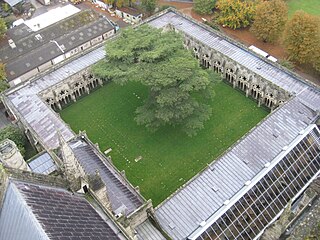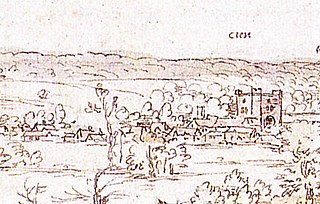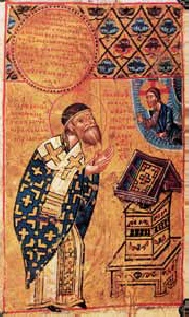Notes
- ↑ St. Walter Catholic Online
Saint Walter | |
|---|---|
| Died | 1250 |
| Venerated in | Roman Catholic Church |
| Feast | 4 June |
Walter was a Benedictine hermit. He later became abbot, being the founder of the monastery of Serviliano in the Marches of Ancona, Italy. This monastery was famed for the rejuvenation pioneered by religious orders in that era. [1]

The Ajanta Caves are 30 rock-cut Buddhist cave monuments dating from the second century BCE to about 480 CE in Aurangabad district of Maharashtra state in India. Ajanta Caves are a UNESCO World Heritage Site. Universally regarded as masterpieces of Buddhist religious art, the caves include paintings and rock-cut sculptures described as among the finest surviving examples of ancient Indian art, particularly expressive paintings that present emotions through gesture, pose and form.

The Abbey of Saint Gall is a dissolved abbey (747–1805) in a Catholic religious complex in the city of St. Gallen in Switzerland. The Carolingian-era monastery existed from 719, founded by Saint Othmar on the spot where Saint Gall had erected his hermitage. It became an independent principality between 9th and 13th centuries, and was for many centuries one of the chief Benedictine abbeys in Europe. The library of the Abbey is one of the oldest monastic libraries in the world.

Emmanuel College is a constituent college of the University of Cambridge. The college was founded in 1584 by Sir Walter Mildmay, Chancellor of the Exchequer to Elizabeth I. The site on which the college sits was once a priory for Dominican monks, and the College Hall is built on the foundations of the monastery's nave. Emmanuel is one of the 16 "old colleges", which were founded before the 17th century.

Melrose is a town and civil parish in the Scottish Borders, historically in Roxburghshire. It lies within the Eildon committee area of Scottish Borders Council.

A cloister is a covered walk, open gallery, or open arcade running along the walls of buildings and forming a quadrangle or garth. The attachment of a cloister to a cathedral or church, commonly against a warm southern flank, usually indicates that it is part of a monastic foundation, "forming a continuous and solid architectural barrier... that effectively separates the world of the monks from that of the serfs and workmen, whose lives and works went forward outside and around the cloister."

Bangor-on-Dee is a village and community in Wrexham County Borough, Wales, on the banks of the River Dee. Until 1974 it was in the exclave of Flintshire known as the Maelor Saesneg, and from 1974 to 1996 in the county of Clwyd.
Crínán of Dunkeld, also called Crinan the Thane, was the hereditary abbot of the monastery of Dunkeld, and perhaps the Mormaer of Atholl. Crínán was progenitor of the House of Dunkeld, the dynasty which would rule the Kingdom of Scotland until the later 13th century. He was the son-in-law of one king, and the father of another.

In Christian iconography, Christ Pantocrator is a specific depiction of Christ. Pantocrator or Pantokrator, literally ruler of all, but usually translated as "Almighty" or "all-powerful", is derived from one of many names of God in Judaism.

The Visoki Dečani Monastery is a medieval Serbian Orthodox Christian monastery located near Deçan, Kosovo. It was founded in the first half of the 14th century by Stefan Dečanski, King of Serbia.
The term Stift is derived from the verb stiften and originally meant 'a donation'. Such donations usually comprised earning assets, originally landed estates with serfs defraying dues or with vassal tenants of noble rank providing military services and forwarding dues collected from serfs. In modern times the earning assets could also be financial assets donated to form a fund to maintain an endowment, especially a charitable foundation. When landed estates, donated as a Stift to maintain the college of a monastery, the chapter of a collegiate church or the cathedral chapter of a diocese, formed a territory enjoying the status of an imperial state within the Holy Roman Empire then the term Stift often also denotes the territory itself. In order to specify this territorial meaning the term Stift is then composed with hoch as the compound Hochstift, denoting a prince-bishopric, or Erzstift for a prince-archbishopric.

The Awakening is a 1928 American synchronized sound feature film directed by Victor Fleming and starring Vilma Bánky. While the film has no audible dialog, it was released with a synchronized musical score with sound effects using both the sound-on-disc and sound-on-film process. The film was based on a story by Frances Marion.

Theodore Stratelates, also known as Theodore of Heraclea, was a martyr and warrior saint in the Eastern Orthodox, Catholic and Oriental Orthodox Churches.

The Battle of Sculeni was fought on 29 June 1821 in Sculeni, Moldavia between Ottoman forces and the Greek revolutionary forces raised by the Filiki Eteria led by Prince George Katakouzenos. The battle came about as the result of Ottoman reprisals for Alexander Ypsilantis' expedition in the two Danubian Principalities, and followed in the aftermath of the Battle of Dragashani. When the Ottomans crossed the Bahlui River in Iaşi on 25 June 1821, Lieutenant Catakouzenos and his forces, originally stationed on the Russian frontier, crossed the Prut River.
Events from the year 1537 in Ireland.

The Poganovo Monastery is a Serbian Orthodox monastery situated in the gorges of the river Jerma, near the village Poganovo, municipality of Dimitrovgrad, Serbia.

St. Faith's Priory, Horsham, otherwise Horsham St. Faith Priory, was a Benedictine monastery in Horsham St Faith, Norfolk, England.

Sheen Priory in Sheen, now Richmond, London, was a Carthusian monastery founded in 1414 within the royal manor of Sheen, on the south bank of the Thames, upstream and approximately 9 miles southwest of the Palace of Westminster. It was built on a site approximately half a mile to the north of Sheen Palace, which itself also occupied a riverside site, that today lies between Richmond Green and the River Thames.

Santa María de Óvila is a former Cistercian monastery built in Spain beginning in 1181 on the Tagus River near Trillo, Guadalajara, about 90 miles (140 km) northeast of Madrid. During prosperous times over the next four centuries, construction projects expanded and improved the small monastery. Its fortunes declined significantly in the 18th century, and in 1835 it was confiscated by the Spanish government and sold to private owners who used its buildings to shelter farm animals.

Jakov of Serres was a medieval Serbian writer, scholar, translator, and hierarch of the Serbian Orthodox Church, one of the most important men of letters working in the 14th century.

Mahāgandhāyon Monastery is a monastic college located in Amarapura, Myanmar. The monastery is known for its strict adherence to the Vinaya, the Buddhist monastic code.